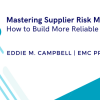Launching an all new product ahead of your competition can determine long term market share and resulting profitability. Sourcing professionals have an amazing opportunity to increase the pace at which their companies bring new products to market by condensing the source-to-pay (S2P) process.
In the previous article, we discussed how automated Plan for Every Part (PFEP) software can free up sourcing teams to focus on more strategic initiatives. Now we’ll look at eight ways to accelerate sourcing with automated PFEP software.
1. Establish a Solid Data Foundation to Ensure Forward Momentum
We have a love-hate relationship with our Excel bill of materials (BOMs). Our sick obsession is fueled by the time invested in developing them. Utilizing Excel file import functions within automated PFEP software can help ease our switching pain from the spreadsheet we know. Re-entering data is never a good idea, so fortunately most automated PFEP software can upload a large Excel BOM in seconds.
Establish a solid data foundation on day one by selecting automated PFEP software that has built-in functionality to audit your Excel BOM as an additional data quality check.
2. Tap Smart Sheets to Eliminate Rework
Smart sheets save you from having to type data into PFEP. For example, users can save time by starting to type a supplier name and then the software recommends potential suppliers. Users can quickly select the desired supplier and the balance of the supplier data is automatically pulled into the automated PFEP.
This micro time savings of a half second might not seem like much but multiplied over a product’s lifecycle it can save serious dollars. Productivity gains can quickly equate to a full-time equivalent headcount savings.
3. Standardize the Template to Increase Efficiency
Yes, many of our organizations have well-established best practice templates for new product BOMs. Truly how often are they used? How much offline analysis is being conducted to fill in the gaps?
Automated PFEP software often comes with off-the-shelf templates of roughly 120 plus data input columns. These can be customized by end users, but as a best practice it is often prudent for an admin user to standardize a company template for everyone to use. One of the benefits of automated PFEP software is that it sets one standard commercial BOM across the enterprise.
4. Leverage Change Feeds to Reduce Human Errors
We spend a lot of time tracking and reporting to leadership on part cost and lead time changes. Today you can automate these commercial changes to free up your time. Automated PFEP Software allows you to review and analyze commercial changes; this is an invaluable new intelligence trove. Managers can now better support their teams by identifying and remediating headwinds faster without the feeling of micromanaging.
5. Automatically Pull Data from PLM to Add Sourcing Time
Free up your time by leveraging Application Programing Interfaces (APIs) to connect your automated PFEP software with your PLM software to automatically pull in data. You will be impressed by the amount of time you save by receiving real-time updates on part changes. The amount of time saved by sourcing teams tracking early part revision changes alone can be worth deploying automated PFEP software. Further, you will gain earlier access to part data; the equivalent of being able to add to your sourcing timeline. This newfound time can be spent on critical and/or long lead parts.
6. Connect to ERP to Enable Seamless Idea to Production Flow
Use a new product production software bridge via APIs to push data from automated PFEP to ERP. This logical next step connects the data divide to create an end-to-end automated product lifecycle solution where all data has a home. The pace at which companies bring new products to market is becoming the new sourcing battleground. Your ability to automatically upload automated PFEP software data versus manually rekeying this information will further reduce sourcing timelines.
7. Automate Reporting with Dashboards to Unlock Time
We are all leaders, regardless of title, so we need real-time access to the latest product data throughout early development to best do our job. Innovation requires swifter decision making based on the latest information. Using automated dashboards that show product key performance indicators, such as tooling target and actual costs, in filterable settings allows each individual and the collective team to digest the right information at the right time.
8. Tap Into Past Product Data to Continuously Improve
Tools like Excel tend to be bespoke pieces of art that don’t translate from colleague to colleague. Thus, they offer little to no insights from program to program for continuous improvement.
Projects in automated PFEP allow you and newer teammates to tap the collective organizational knowledge to unlock synergies across your department and globally. As an example, you can track past engaged suppliers that quoted years ago, review conversation notes, see response times and copy past product PFEPs to save time.
Source Faster to Build Competitive Advantage
As you look to accelerate your new product sourcing, leverage these actions to pick up your pace. There is no one secret to sourcing speed. You must put in the work. However, the more you take a hard look at your current early BOM and automate, the faster your sourcing process will be.
A phased deployment approach for BOM automation is a proven recipe for success. Every step you automate will save valuable time, so getting started is key. Focus on deploying Automated PFEP software first, connect to PLM then later connect to ERP. Highlight time saved with each automation step to build momentum. At the end of the day, our new products are only as good as their ability to meet commercial targets in an acceptable launch timeframe. Replace your manual Excel BOMs with Automated PFEP Software to accelerate sourcing.









